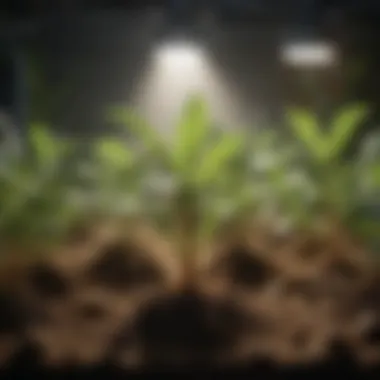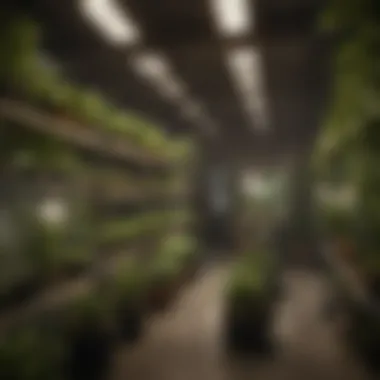Digital Grow Light: Transforming Horticulture Practices


Intro
The realm of horticulture is undergoing a transition. Traditional methods of cultivating plants face new challenges and opportunities due to technological advancements. One pivotal development is the rise of digital grow lights, a tool that offers precise control over light conditions crucial for plant growth. Understanding this innovation requires a closer look at its definition, applications, benefits, and the underlying science that supports its effectiveness.
Overview of the Topic
Definition and Importance
Digital grow lights refer to advanced lighting systems designed to create optimal conditions for plant development by regulating light spectra, intensity, and duration. Unlike conventional grow lights, which often provide generic light outputs, digital grow lights use smart technology to tailor the light spectrum according to the plant species and growth stage. This level of customization not only enhances plant health but also maximizes yield in various growing environments.
Current Trends
Today's horticulture market sees a surge in the adoption of digital grow lights. Farmers and enthusiasts alike are increasingly aware of the need for sustainable practices. Many are moving towards energy-efficient LED systems that can replicate natural sunlight more accurately. Additionally, integration with smart farming technology is on the rise. Remote monitoring and control systems allow growers to adjust light settings easily and even analyze plant responses in real-time. Relevant resource.
Key Techniques and Practices
Step-by-Step Guide
- Assess Growing Needs: Identify the specific plants and their light requirements during different growth phases.
- Select Suitable Technology: Choose digital grow lights best suited for the plants and growing conditions, such as indoor or vertical farms.
- Installation: Position lights at the correct distance and angle to avoid light burn while ensuring adequate coverage.
- Set Light Cycles: Implement schedules for light periods that mimic natural day and night cycles, or customize them based on plant needs.
- Monitor Growth: Regularly reassess plant health and adjust light intensity and spectrum as plants mature.
Tools and Equipment Needed
- Digital grow lights (LED, fluorescent, or HPS types)
- Light meters for measuring intensity
- Timers for controlling light cycles
- Sensors for environmental monitoring (humidity, temperature)
- Software for managing light schedules and analyzing data
Challenges and Solutions
Common Obstacles
While digital grow lights offer numerous advantages, users often encounter challenges. High initial costs can deter some growers. Also, selecting the wrong light spectrum for specific plants leads to suboptimal growth. Often, beginners may struggle with setting appropriate light cycles, leading to plant stress.
Innovative Solutions
Various solutions exist to address these obstacles. Many manufacturers now offer entry-level options that are more affordable for hobbyists and small-scale farmers. Educational resources, including forums like Reddit and educational videos on platforms like Facebook, provide vital information. Additionally, many digital grow lights come with programmable features that simplify light management, ensuring users can quickly adapt to plant needs.
Harnessing the full potential of digital grow lights can dramatically change the landscape of modern horticulture, promoting sustainability and efficiency in plant production.
Ultimately, as horticulture continues to evolve, digital grow lights represent a significant advancement by combining technology with plant science to foster innovative growing practices.
Understanding Digital Grow Lights
Understanding digital grow lights is essential in today’s horticultural practices. These advanced lighting systems offer significant advantages over traditional grow lights. The integration of technology into plant cultivation leads to better control and enhanced productivity in various growing environments. Digital grow lights cater to the specific light requirements of plants, allowing for optimal growth through precise light spectrums.
Definition of Digital Grow Lights
Digital grow lights are specialized lighting systems designed for horticultural applications. They utilize advanced technology to simulate natural sunlight, providing plants with the necessary light spectrums for photosynthesis. These systems often incorporate LEDs, allowing for varying intensities and colors of light, which can be adjusted according to plant needs. The digital aspect refers to their ability to be controlled via electronic systems. This control can range from simple timers to sophisticated setups that handle temperature and humidity as well.
To put it simply, digital grow lights facilitate a more tailored approach to plant growth. They provide light when plants need it most, reducing energy waste and promoting healthier growth. The efficiency of using digital grow lights not only improves plant health but also optimizes resource usage in agricultural practices.
Evolution of Grow Light Technology
The evolution of grow light technology has seen remarkable advancements over the years. Initially, horticulturists relied on conventional incandescent bulbs, which were inefficient and produced a lot of heat, often impacting growth negatively. As research in horticulture continued, fluorescent lamps became a popular alternative. While more efficient, they still lacked the capability to provide full-spectrum light that plants require.
The introduction of High-Intensity Discharge (HID) lights marked another significant shift. These lights offered greater intensity and were preferred by commercial growers. However, they also had limitations such as high energy consumption and heat output.
The late 20th century witnessed the rise of LED technology, transforming the horticultural landscape. LEDs are energy-efficient, long-lasting, and capable of delivering specific light spectrums. Their adaptability has allowed growers to customize light conditions for a variety of plants, making them a preferred choice in modern horticulture.
"LED grow lights have pushed the boundaries of what is possible in indoor gardening and commercial agriculture."
Today, digital grow lights encompass LED technology with smart controls, allowing for even more precise management of light conditions. The evolution from basic incandescent bulbs to advanced digital systems reflects ongoing innovation in the quest for more efficient and effective growing solutions.
The Science of Light in Horticulture
The role of light in horticulture is crucial for sustaining plant growth and development. Digital grow lights have transformed the way we understand and utilize light frequencies in plant cultivation. This section focuses on the science behind light and its relationship with plants. It highlights the specifics of light spectrums, the process of photosynthesis, and the importance of different wavelengths. Understanding these components is essential for maximizing the benefits of digital grow lights.
Understanding Light Spectrums


Light spectrums describe the different wavelengths of light that plants can utilize for photosynthesis. Each wavelength can affect plant growth in various ways. Light each spectrum has specific roles; for example, blue light promotes vegetative growth, while red light supports flowering.
The spectrum of light is divided into several ranges:
- Ultraviolet (UV): Generally harmful but can aid in pest resistance.
- Visible Light: Includes the wavelengths we can see, and is crucial for photosynthesis.
- Infrared (IR): Not used directly in photosynthesis but affects temperature and plant processes.
By utilizing digital grow lights that can emit specific spectrums, cultivators can tailor the light environment to fit the needs of different plants throughout their growth cycles. This precision lighting is an essential benefit of modern horticulture.
Photosynthesis and Light Absorption
Photosynthesis is the process through which plants convert light energy into chemical energy. This process occurs mainly in the chloroplasts and enables plants to create their food. Light absorption is critical for effective photosynthesis, as not all wavelengths are equally absorbed by plant leaves.
Chlorophyll is the pigment responsible for absorbing light, specifically in the blue and red parts of the spectrum. As plants absorb light, they convert carbon dioxide and water into glucose and oxygen. Without sufficient light, this process slows, causing growth to stagnate.
Important Note: Insufficient light can lead to poor plant health and reduced yields.
The Role of Wavelengths
Wavelengths of light play distinct roles in plant behavior. Each wavelength influences plant biology differently:
- Blue Light (400–500 nm): Increases leaf growth and overall plant structure.
- Red Light (600–700 nm): Promotes flowering and fruit production.
- Green Light (500–600 nm): Although less absorbed, it penetrates deeper into leaves and can affect plant growth.
Other wavelengths, such as far-red light, can signal changes in growth patterns, like stretching or phototropism. Growing environments using digital grow lights can deliver precise wavelengths beneficial for targeted growth phases, further advancing cultivation practices. Understanding how and when to use these wavelengths can lead to significant enhancements in plant production.
Types of Digital Grow Lights
Understanding the various types of digital grow lights is essential for anyone involved in horticulture. Each type offers unique benefits and considerations that cater to different gardening needs and conditions. The choice of grow light can significantly influence plant growth rates, energy consumption, and overall success in cultivating plants. Therefore, being informed about these types can help agricultural professionals and enthusiasts make smarter choices that align with their specific goals.
LED Grow Lights
LED (Light Emitting Diode) grow lights have become increasingly popular in recent years. They are energy efficient and have a longer lifespan compared to traditional lighting options. One key advantage of LED lights is their ability to produce specific wavelengths of light that plants need for photosynthesis. This specificity allows for better control over plant growth and encourages faster development.
LED grow lights generate minimal heat, reducing the risk of overheating plants. Furthermore, they come in various spectrums, making them suitable for all growth stages from seedling to flowering. The initial investment may be higher, but savings on electricity bills can offset this cost over time, making LEDs a cost-effective option in the long run.
Fluorescent Grow Lights
Fluorescent grow lights are another common choice among indoor gardeners. They are widely available and relatively inexpensive. These lights produce a cool light, which is less likely to trap heat, allowing plants to thrive without the risk of sunburn. Fluorescents come in two main types: T5 and compact fluorescent lights (CFLs).
T5 lights are thinner and allow for higher output in a compact design. This makes them ideal for smaller spaces. CFLs, on the other hand, are more portable and easier to replace. While they may not be as efficient as LEDs, they are suitable for germinating seedlings and for use in herb gardens. Therefore, fluorescent lights remain a solid option, particularly for beginners or for experiments in plant growth.
High-Intensity Discharge (HID) Lights
High-Intensity Discharge (HID) lights have been used for many years in commercial horticulture. They are known for their ability to produce a high lumen output, benefiting large-scale operations like greenhouses. Two primary types of HID lights are Metal Halide (MH) and High-Pressure Sodium (HPS).
MH lights emit blue light, which is great for vegetative growth, while HPS lights emit red light, favoring flowering and fruiting stages. An essential factor to consider is that HID lights come with higher energy consumption and generate considerable heat. This necessitates proper ventilation and cooling systems to safeguard plant health. The initial purchase price is lower compared to LEDs, but operational costs can accumulate significantly over time.
Benefits of Using Digital Grow Lights
The use of digital grow lights represents a significant advancement in horticultural practice, offering various benefits that can enhance both personal gardening and commercial agriculture. One of the most important aspects to consider is how these lights can lead to improved plant growth. The controlled environment produced by digital grow lights allows for precise adjustments that will satisfy the unique needs of different plants. In addition, their efficiencies contribute to better energy usage and overall lower costs.
Enhanced Growth Rates
Digital grow lights are designed to provide specific light spectrums that cater to the growth stages of plants. They can emit light that mimics the sun’s natural rays. This mimicry is crucial during the photosynthesis process, as it directly influences how plants grow and develop. When using digital grow lights, plants typically experience faster growth rates, improved yields, and healthier structures. For instance:
- Seedling Stage: The blue spectrum is most effective at promoting vegetative growth.
- Flowering Stage: A shift to a red spectrum can promote flowering and fruiting, which is essential for harvest.
"By adjusting light spectrums and intensities, growers can accelerate growth cycles and achieve better harvests."
This dynamic adaptability is a substantial advantage for indoor gardeners or those in controlled horticultural environments, allowing for year-round production irrespective of external weather conditions.
Energy Efficiency
Energy consumption is a growing concern in modern agriculture. Digital grow lights such as LEDs are significantly more energy-efficient than traditional lighting solutions. They convert a higher percentage of electrical energy into usable light, reducing energy costs and the carbon footprint of agricultural operations. Furthermore, some digital grow lights have automated systems that adjust based on plant needs, optimizing energy use.
Consider the following factors:


- Lower Heat Emission: This reduces cooling needs in environments such as greenhouses.
- Longer Lifespan: Digital grow lights often have a longer operational life than conventional bulbs, resulting in fewer replacements needed.
Overall, implementing energy-efficient lighting not only benefits the environment, it also positively impacts profitability.
Better Control Over Plant Growth
The digital aspect of these grow lights provides growers with unprecedented control. Users can fine-tune light intensity, duration, and spectrums to fit specific plant requirements. This precise adjustment encourages optimal growth phases.
For instance, reducing light during certain growth stages can mimic seasonal changes, enabling plants to enter dormancy or prepare for flowering. Some advanced systems even incorporate sensors and automated adjustments for real-time control.
This level of control can lead to higher quality crops. It allows the grower to manage variables like pest management and nutrient allocation more effectively. So, for those aiming for maximum results, digital grow lights offer more than just illumination; they provide a robust framework for advanced horticultural management.
Applications of Digital Grow Lights
Digital grow lights have transformed multiple domains within horticulture. Their versatility enables indoor gardeners, commercial growers, and researchers to harness light effectively for plant growth. These applications ensure not just the survival, but the thriving of various plants in non-traditional settings.
Indoor Gardening and Hydroponics
Indoor gardening has witnessed a surge in popularity due to limited space in urban settings. Digital grow lights serve as a critical factor in this trend. They facilitate proper growth by providing the necessary light spectrums in confined environments. In hydroponic setups, where plants are grown without soil, light becomes the essential energy source.
Using digital grow lights allows for customized light handling. For instance, different plants require varying wavelengths for optimal growth. LEDs can be tuned to deliver specific red and blue lights that enhance photosynthesis, leading to faster growth rates. Furthermore, these lights produce less heat than traditional lights, which is crucial to prevent overheating in small spaces. The control over light intensity and duration is another advantage; it allows gardeners to mimic natural daylight cycles effectively.
Commercial Greenhouses
Commercial greenhouses leverage digital grow lights to optimize cultivation processes. These lights extend the growing season, allowing producers to cultivate year-round, regardless of external weather conditions. Moreover, they assist in maximizing crop yields by using specific light wavelengths optimal for particular plants.
In such settings, energy efficiency is a key point. Digital grow lights consume less electricity than older lighting technologies. This efficiency translates into lower operational costs. Additionally, growers can install advanced control systems for these lights, aligning them with climate conditions and plant needs, thus enhancing overall productivity. As agricultural demands increase, using grow lights in greenhouses becomes a viable strategy for meeting market needs while managing costs.
Research and Development in Agriculture
In research environments, understanding light's role in plant growth is paramount. Digital grow lights offer precise control needed for experimental setups. Researchers can adjust variables such as light intensity, spectrum, and photoperiods to study their effects on plant physiology and development.
This adjustable nature aids in breeding programs and genetic studies. For instance, investigating how different spectrums impact various traits can lead to more tailored plant varieties. Furthermore, digital grow lights support developments in nutrient research by allowing scientists to create controlled conditions to study interactions between light and nutrient intake. In essence, they offer invaluable tools for advancing agricultural science.
Digital grow lights are pivotal in revolutionizing various horticultural applications. Their specific uses enrich indoor gardening, enhance yield in commercial operations, and propel agricultural research forward.
Considerations for Choosing Digital Grow Lights
Selecting the right digital grow light is pivotal for maximizing the productivity of horticultural practices. As technology continuously evolves, various models offer distinct benefits and features. Understanding the core aspects of choosing an appropriate grow light can lead to improved plant health and development. Here are key considerations.
Plant Types and Light Requirements
Different plants have diverse light needs for optimal growth. For instance, leafy greens like lettuce or spinach thrive in lower light conditions, while fruiting plants such as tomatoes or peppers require higher light intensity. To make informed choices, one should consider the following factors:
- Light Intensity: This determines the brightness of the light and is measured in lumens. Higher intensity is crucial for fruit-bearing plants.
- Light Spectrum: Various wavelengths are essential for different growth phases. For example, blue light promotes vegetative growth, while red light aids in flowering and fruiting.
- Duration of Light Exposure: The photoperiod, or the length of time the plants are exposed to light, is also a critical aspect.
By analyzing these attributes, users can tailor their grow light setup to meet the specific requirements of their plants, ultimately leading to better outcomes.
Cost vs. Benefit Analysis
Another fundamental element in choosing digital grow lights is the cost versus benefit aspect. While initial investments may seem high, one must evaluate long-term advantages to make a justified decision. Important considerations include:
- Energy Efficiency: Digital grow lights often consume less power compared to traditional sources like HID or fluorescent lights. Analyze the energy costs over time and consider the impact on electricity bills.
- Lifespan: LEDs typically last longer than other types, reducing the frequency of replacements. This longevity contributes to lower maintenance costs.
- Yield Improvement: Enhanced light quality can lead to greater plant yields. A careful analysis can inform whether the price of advanced lighting technology is justifiable based on expected crop yields.
Conducting a thorough cost-benefit analysis ensures a balanced view and encourages informed purchasing decisions.
Installation and Setup Considerations
When setting up digital grow lights, various installation elements require attention to ensure proper functioning. Factors to bear in mind include:
- Location: The placement of the lights should provide an even distribution of light. Overhead mounts or wall installations could be utilized based on the growing space layout.
- Height Regulation: Distances between plants and lights must be adjusted as plants grow to prevent burning or inadequate lighting. Periodic monitoring will help in maintaining the optimal distance.
- Cooling and Ventilation: Some lights may produce heat. Ensuring proper ventilation around the installation area can prevent damage or stress to plants.
"Proper setup is essential for achieving the desired results from digital grow lights."
Future Trends in Digital Grow Light Technology


The realm of digital grow lights is continuously evolving, integrating advanced technology and responding to environmental challenges. Moving forward, the trends in this technology could significantly influence horticulture, shaping the way plants are cultivated and impacting agricultural practices globally.
Advancements in Smart Technology
Smart technology is becoming an integral part of digital grow light systems. With innovations in IoT (Internet of Things), farmers can monitor and control their lighting setup remotely. This means they can tailor light intensity and spectrum with precision from their mobile devices.
Some key features of smart grow light systems include:
- Automated control: Smart systems can adjust light output based on real-time conditions such as plant growth stage and external weather.
- Data analytics: By collecting data on environmental factors, these systems can provide insights that enhance growth outcomes.
- Integration with sensors: Sensors can monitor humidity, temperature, and CO2 levels, ensuring optimal conditions for plant development.
These advancements not only optimize plant growth but can also lead to significant energy savings, improving overall operational efficiency.
Sustainability and Environmental Impact
The conversation around sustainability is becoming increasingly relevant in horticulture. Digital grow lights have the potential to reduce the carbon footprint of farming practices. Compared to traditional methods, smart grow lights require less energy and produce less waste.
Some important considerations include:
- Energy reduction: Modern LED lights consume significantly less energy than older incandescent or fluorescent lights. This reduces greenhouse gas emissions associated with energy production.
- Resource efficiency: Innovations like targeted lighting reduce the need for excessive water and fertilizers, thus preserving valuable natural resources.
- Waste management: Many digital grow lights are made from recyclable materials, contributing to a circular economy in agriculture.
"The future of digital grow lights is not just about enhancing plant growth but ensuring that we do it in a way that protects our planet for future generations."
Overall, the trends in digital grow light technology embody a shift towards smarter, more sustainable horticultural practices. By staying informed about these advancements, both farmers and enthusiasts can adapt their approaches, leading to innovations that not only boost productivity but also contribute positively to the environment.
Case Studies of Successful Implementations
Case studies of successful implementations of digital grow lights provide critical insights into their practical application within urban farming and educational institutions. These examples demonstrate not only the effectiveness of these technologies but also their adaptability and impact on productivity and sustainability. By examining such implementations, horticultural professionals can glean lessons applicable to their own operations, ensuring optimal use of resources and techniques. This analysis reveals specific challenges, measurable outcomes, and innovative methodologies that can be replicated or adapted.
Commercial Success in Urban Farming
Urban farming has rapidly emerged as a significant sector in agricultural innovation, heavily relying on digital grow lights. For example, Brooklyn Grange utilizes LED grow lights in their rooftop farms to maximize crop yield in limited space. Their choice of light spectrum is meticulously aligned with the needs of the plants they cultivate, enabling them to produce a variety of vegetables year-round, despite environmental constraints.
Key benefits noted include:
- Higher Crop Density: The efficient use of vertical space allows for a larger number of plants per square foot.
- Season Extension: Using digital grow lights enables production cycles to extend beyond typical growing seasons.
- Quality Improvement: Plants grown under controlled lighting conditions show notable improvements in taste and nutrient content.
Another successful example is Square Roots, an urban farming venture that integrates smart technology with vertical farming. Their systems leverage data analytics to optimize light conditions, leading to improved growth rates and crop quality. This case illustrates the powerful combination of technology and horticulture, emphasizing how nuanced control over the light environment can enhance productivity.
"The integration of digital grow lights in urban farming settings revolutionizes how we approach agriculture in space-constrained environments."
Educational Institutions and Research
Educational institutions are also using digital grow lights to advance research and training in horticulture. For instance, California State University, Fresno, has implemented LED lighting solutions in their agricultural programs, allowing students to engage with the best practices in modern horticulture. This hands-on experience is invaluable for cultivating future leaders in the industry.
Research programs benefit in several ways:
- Controlled Experiments: Digital grow lights facilitate rigorously controlled experimental conditions for studying plant responses to varying light spectrums.
- Sustainability Education: Institutions can showcase sustainable practices by demonstrating how energy-efficient lighting promotes eco-conscious agriculture.
- Collaborative Projects: Partnerships with industry leaders help students understand real-world implications and the latest technological advancements.
This approach not only enhances classroom learning but also prepares students for the complexities of horticulture in various environments. Successful case studies in these key areas underscore the potential of digital grow lights to reshape our understanding and practices in horticulture on both commercial and educational fronts.
End and Future Outlook
The shift towards digital grow lights marks a significant milestone in the evolution of horticulture. This technology not only optimizes plant growth but also addresses critical issues such as resource management and sustainable practices. The conclusion serves to emphasize the major themes discussed throughout the article, connecting the detailed information about digital grow lights with their broader implications in modern agriculture.
Summarizing the Impact of Digital Grow Lights
Digital grow lights have transformed the traditional approaches to horticulture. They offer a controlled environment for plants to thrive, ensuring consistent growth regardless of external weather conditions. Here are the key impacts of digital grow lights:
- Enhanced Growth Rates: Plants under digital grow lights exhibit accelerated growth compared to those relying solely on sunlight.
- Energy Efficiency: These lights are designed to consume less energy, which can lead to reduced operational costs in farming.
- Customization: Growers can tailor light spectrums specifically for different stages of plant development, an invaluable advantage for optimizing yields.
"Digital grow lights stand as a beacon of innovation, illuminating not just plants but the future of sustainable farming practices."
The significance of these lights extends beyond mere functionality; they embody a shift in mindset towards innovative agricultural practices. Farmers who adopt these technologies are better positioned to meet the challenges posed by climate change and resource scarcity.
The Path Forward: Innovation in Horticulture
The future of horticulture will undoubtedly be shaped by ongoing advancements in digital grow light technology. As the industry continues to evolve, several trends are likely to emerge:
- Integration of Smart Technology: The incorporation of AI and IoT devices will allow for real-time monitoring and adjustments of light settings based on plant needs.
- Increased Sustainability: Further innovations will aim to minimize environmental impact, focusing on renewable energy sources that power these grow lights.
- Broader Accessibility: As technology advances, digital grow lights are expected to become more affordable, allowing smaller growers and hobbyists access to sophisticated lighting solutions.
To sum up, the journey of digital grow lights parallels the quest for proficiency in agricultural practices. These innovations are not just technical solutions; they are integral to promoting a sustainable future in horticulture. As the industry embraces these changes, the avenues for growth, both literally and figuratively, will expand immensely.



